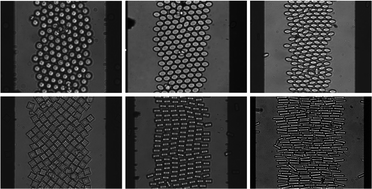Design rules for 2D field mediated assembly of different shaped colloids into diverse microstructures
Abstract
Assembling different shaped particles into ordered microstructures is an open challenge in creating multifunctional particle-based materials and devices. Here, we report the two-dimensional (2D) AC electric field mediated assembly of different shaped colloidal particles into amorphous, liquid crystalline, and crystalline microstructures. Particle shapes investigated include disks, ellipses, squares, and rectangles, which show how systematic variations in anisotropy and corner curvature determine the number and type of resulting microstructures. AC electric fields induce dipolar interactions to control particle positional and orientational order. Microstructural states are determined via particle tracking to compute order parameters, which agree with computer simulations and show how particle packing and dipolar interactions together produce each structure. Results demonstrate how choice of particle shape and field conditions enable kinetically viable routes to assemble nematic, tetratic, and smectic liquid crystal structures as well as crystals with stretched 4- and 6-fold symmetry. Results show it is possible to assemble all corresponding hard particle phases, but also show how dipolar interactions influence and produce additional microstructures. Our findings provide design rules for the assembly of diverse microstructures of different shaped particles in AC electric fields, which could enable scalable and reconfigurable particle-based materials, displays, and printing technologies.



 Please wait while we load your content...
Please wait while we load your content...